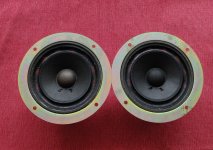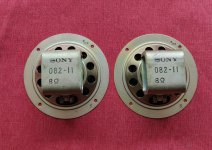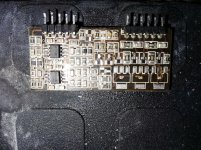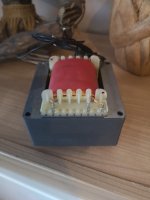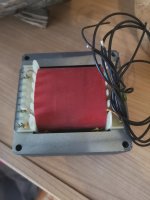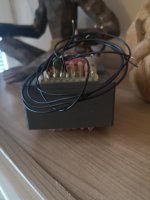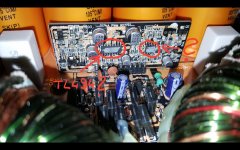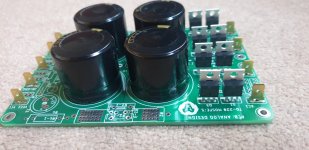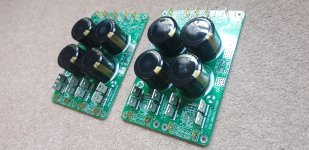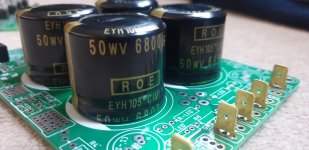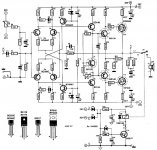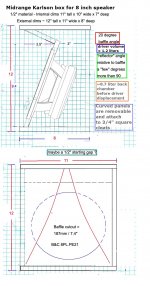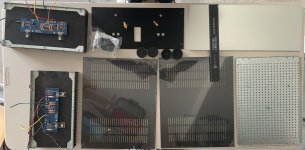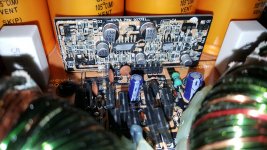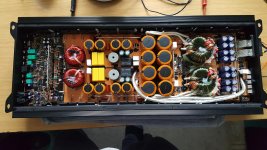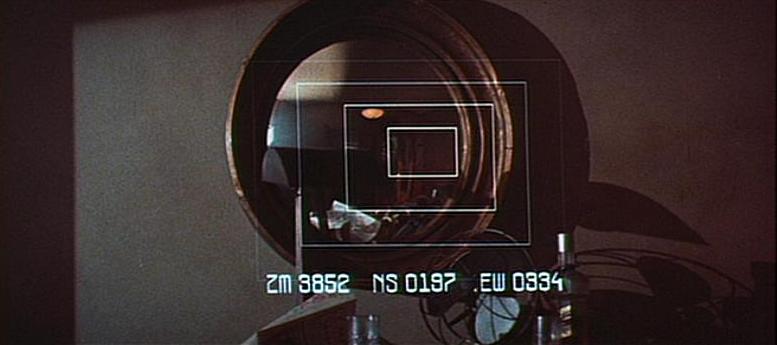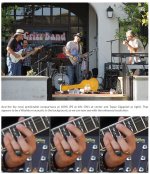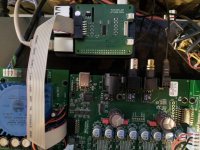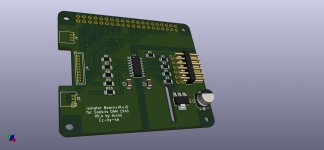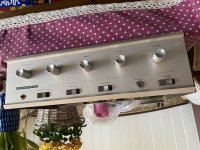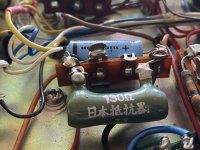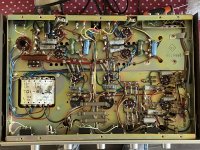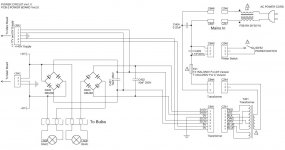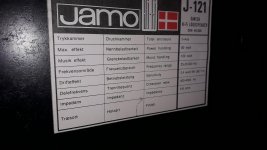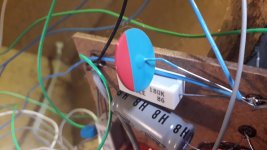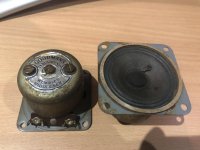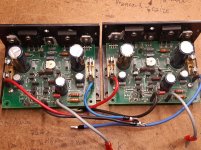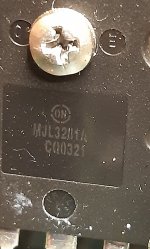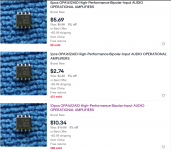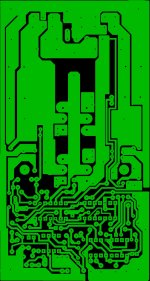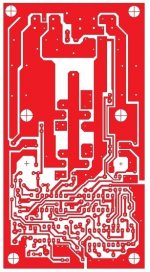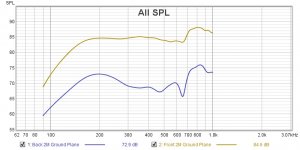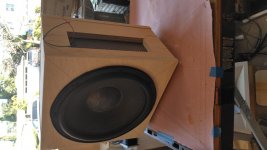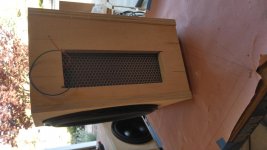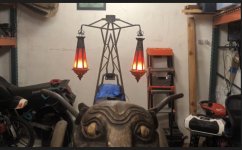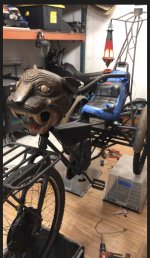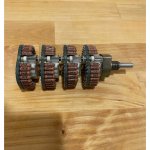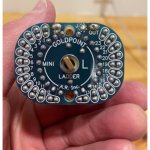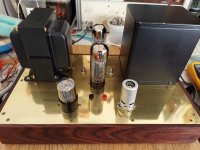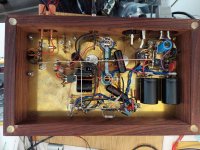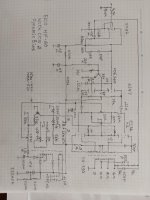Hifonics VIII Zeus in protect
This amp will COLD power up if you let it sit for an hour un-touched, but as soon as you try to test anything or plug anything in like speakers, RCA, or practically touch anything with the oscope, etc - it drops straight into protect like it's scared.
Its funny when it tries to power up, I hear it some stressing through the transformer but twisting it changes nothing. To me it seems like the amp tries to HOT power up about 3 times and then stops as thats what I see it pulling on my bench PS. Currently how it sits it is stuck in protect unless I wait. I tried draining some of the caps but I must not be draining the right one; because then I can probably get it to power up correctly for a few minutes or so. Its using TL594 and a new one for me for latch - which is a 14-pin device with 2B4 HA17324 on it. Looks a little slick too not like a normal IC. Looks custom maybe? Manufactured marking looks like a little camera inside of a circle. Thought it was OnSemi but is not.
Anyways, I tried removing Q1 which is an A1038 but that didn't change anything. I thought removing it would help produce a power up while disabling some of the protect circuitry but I was wrong.
Nothing blown nor shorted on the sides of the board. Board health looks great.
Looks like a newer revision but the revision # is scratched out on the board. This board is not using TIP102/107's tied to the outputs like I've seen in the past on older rev VIII Zeus boards.
TL594
1: 10.00
2: 4.96
3: 4.86
4: 0.917
5: 1.470
6: 3.545
7: 0.003
8: 13.04
9: 0.002
10: 0.001
11: 13.04
12: 12.52
13: 5
14: 5
15: 11.16
16: 6.25
HA17324
1: 11.08
2: 6.25
3: 11.16
4: 12.33
5: 10.20
6: 6.25
7: 11.57
8: 10.68
9: 6.25
10: 10.68
11: 0.003
12: 10.20
13: 6.25
14: 11.08
These readings are the same with Q1 removed.
During the brief power-ups, I am able to sense decent enough rail voltage. I'm measuring about +-54v, +-30v, and +-17v on the rectifiers, and I believe +-54v on the outputs.
There was no DC on the speaker terminals when the amp was able to cold-power up, but once 'charged' I briefly see about +-1vDC on the terminals.
Is there a part I can pull to stop it flying into protect (So that I can do further troubleshooting) or is this one for Stephen Mantz?
Its funny when it tries to power up, I hear it some stressing through the transformer but twisting it changes nothing. To me it seems like the amp tries to HOT power up about 3 times and then stops as thats what I see it pulling on my bench PS. Currently how it sits it is stuck in protect unless I wait. I tried draining some of the caps but I must not be draining the right one; because then I can probably get it to power up correctly for a few minutes or so. Its using TL594 and a new one for me for latch - which is a 14-pin device with 2B4 HA17324 on it. Looks a little slick too not like a normal IC. Looks custom maybe? Manufactured marking looks like a little camera inside of a circle. Thought it was OnSemi but is not.
Anyways, I tried removing Q1 which is an A1038 but that didn't change anything. I thought removing it would help produce a power up while disabling some of the protect circuitry but I was wrong.
Nothing blown nor shorted on the sides of the board. Board health looks great.
Looks like a newer revision but the revision # is scratched out on the board. This board is not using TIP102/107's tied to the outputs like I've seen in the past on older rev VIII Zeus boards.
TL594
1: 10.00
2: 4.96
3: 4.86
4: 0.917
5: 1.470
6: 3.545
7: 0.003
8: 13.04
9: 0.002
10: 0.001
11: 13.04
12: 12.52
13: 5
14: 5
15: 11.16
16: 6.25
HA17324
1: 11.08
2: 6.25
3: 11.16
4: 12.33
5: 10.20
6: 6.25
7: 11.57
8: 10.68
9: 6.25
10: 10.68
11: 0.003
12: 10.20
13: 6.25
14: 11.08
These readings are the same with Q1 removed.
During the brief power-ups, I am able to sense decent enough rail voltage. I'm measuring about +-54v, +-30v, and +-17v on the rectifiers, and I believe +-54v on the outputs.
There was no DC on the speaker terminals when the amp was able to cold-power up, but once 'charged' I briefly see about +-1vDC on the terminals.
Is there a part I can pull to stop it flying into protect (So that I can do further troubleshooting) or is this one for Stephen Mantz?
